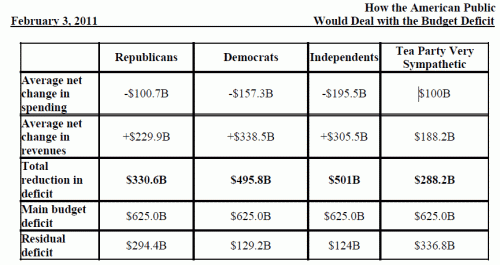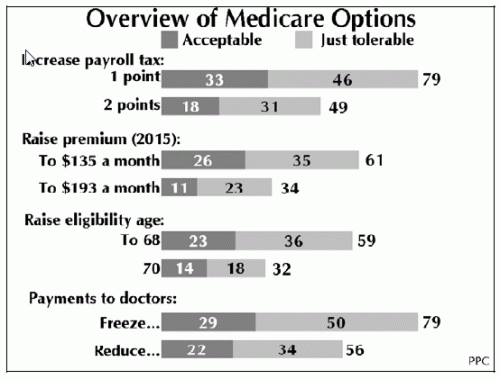Interesting study from The Program on Public Consultation at the University of Maryland School of Public Policy detailing how the public would deal with the budget deficit (h/t Steve Sisson via email). The authors frame the study against a backdrop of polls that seem to provide irrational responses to the budget deficit, which they feel occurs because of how information is provided in polls.
The purpose of this study was to give a representative sample of Americans the chance to deal with the problem of the budget in such an integrated framework, one in which they would make tradeoffs. The goal was to have respondents face the kinds of challenges that policymakers face when making a budget. In this way we can see whether Americans are able to deal with such a challenge, and whether they in fact know what their value priorities are.
The Program worked with the Staff of the President’s Fiscal Commission to design study materials that would allow citizens to make informed trade-offs, and split the budget into Medicare and Social Security since they have dedicated funding streams, as distinct from the discretionary budget (incl. Defense). They did not address Medicaid in the study given its complex funding arrangements. The participants (N=1,250) reached a surprising level of consensus about how to reduce the deficit that results from the discretionary spending portion of the budget (which they projected to be $625 Billion in 2015). Note that according to the text, the column ‘Tea Party Very Sympathetic’ should have a negative sign in front of $100B and a positive in front of $188.2B, for a total deficit reduction of $288.2B in 2015.
 The average choices of all groups reduced, but did not eliminate, the default discretionary budget deficit of $625 Billion that is projected for 2015, via a mix of spending cuts and tax increases. Independents and Democrats achieved the most deficit reduction and had the smallest remaining deficit ($124B and $129.9B respectively), while those self-identifying as very sympathetic to the tea party having the highest remaining deficit in 2015 ($336.8B). Looking at detailed information in the report, you can see fairly substantial majorities for many program cuts and tax increases. Respondents seemed to address this portion of the budget deficit in a straightforward manner without too much trouble.
The average choices of all groups reduced, but did not eliminate, the default discretionary budget deficit of $625 Billion that is projected for 2015, via a mix of spending cuts and tax increases. Independents and Democrats achieved the most deficit reduction and had the smallest remaining deficit ($124B and $129.9B respectively), while those self-identifying as very sympathetic to the tea party having the highest remaining deficit in 2015 ($336.8B). Looking at detailed information in the report, you can see fairly substantial majorities for many program cuts and tax increases. Respondents seemed to address this portion of the budget deficit in a straightforward manner without too much trouble.
When it came to Medicare’s contribution to the deficit (projected at $400 Billion in 2015), the participants had a harder time. Four options were highlighted: increasing payroll taxes; increasing Part B premiums; raising the Medicare eligibility age; or reducing payments to physicians. In short, a majority viewed none of these options as being acceptable. The most popular proposal was a 1 percentage point increase in the Medicare payroll tax that was viewed as acceptable by 33% of respondents, and tolerable by nearly another half. Interestingly, this would generate around $68 Billion in revenue in that year, or three times less revenue than the average amount of revenue increase embraced by the most tax averse group when focusing on the discretionary budget.
Respondents were not eager to raise taxes or premiums or to reduce benefits by increasing the eligibility age when focusing on Medicare. Neither were they eager to reduce Medicare payments to doctors. However, Medicare is a key driver of the long term deficit, and it is not possible to obtain a balanced budget via cutting discretionary spending only. What does this mean? Why could respondents arrive at a consensus of cuts and tax increases for the discretionary budget but not in Medicare? What can we do to counter the seeming unwillingness of the public (even when educated and provided information in a meaningful manner) to identify ways to slow Medicare costs even as many say we must do so?
Perhaps the best hope is to address the discretionary budget aspects of the deficit via a mixture of budget cuts and tax increases, and move to have more dedicated payroll tax funding of Medicare, perhaps increasing the payroll tax to include the substantial Part B support that now comes from the general fund (income taxes). Then we could have a regime whereby the payroll tax automatically increases both in rate, as well as in the proportion of wages to which it applies as the cost of Medicare increases. Perhaps with increased focus on the cost of Medicare, then over time we will embrace cost cutting strategies. Or perhaps we just really like health care spending, and we will decide it is worth it.


